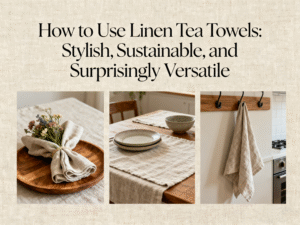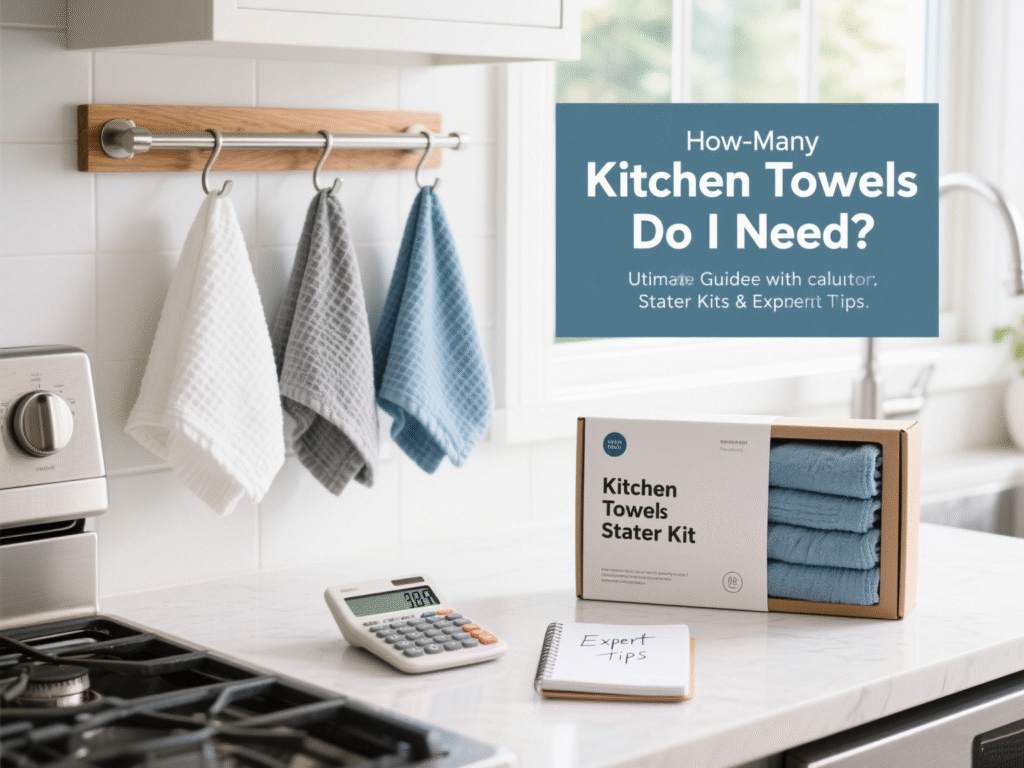
How many kitchen towels do I need? It’s a surprisingly common question—and one that many people get wrong. Most households either have too few towels, leading to constant laundry, or far too many, with half sitting unused in a drawer. The right number depends on your household size, cooking habits, and cleaning routines.
In this guide, we’ll break it down with simple numbers, a practical calculator, and expert tips you can actually use to stock your kitchen efficiently and hygienically.
How Many Kitchen Towels Do I Need for My Household?
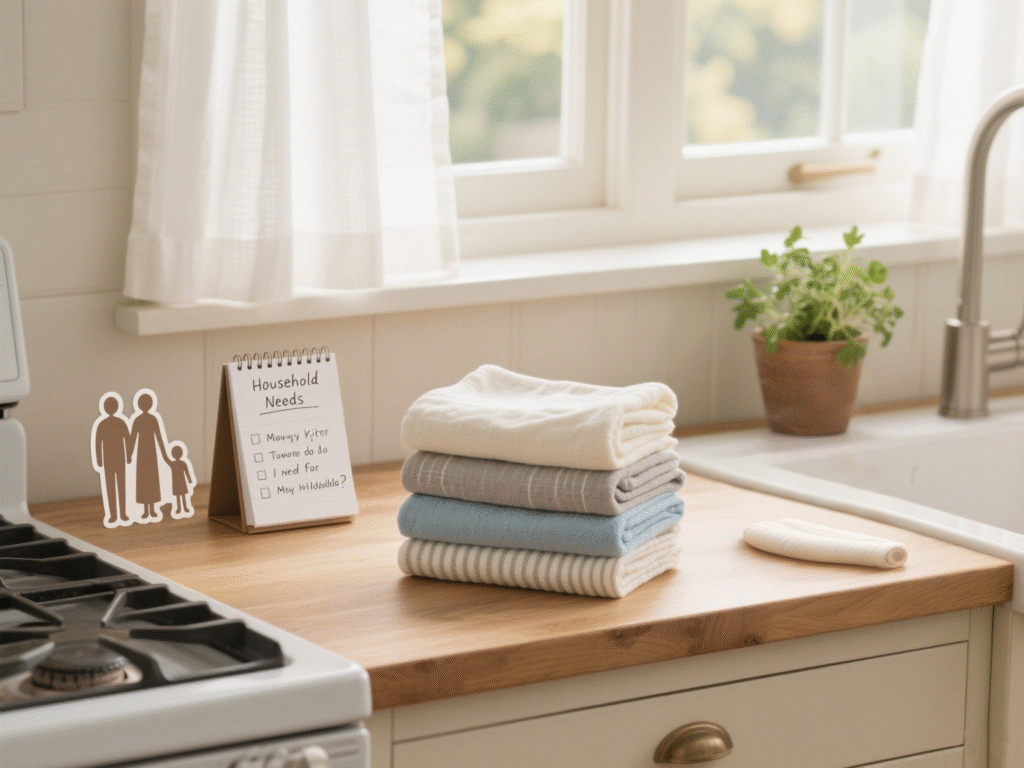
Here’s a simple rule of thumb you can apply right away:
- 2–3 towels per person per week (minimum)
- Average household (3–4 people): 8–12 towels
- Large families or frequent cooks: 15–20 towels
This range works for most households because it balances daily use, washing frequency, and a few extras for unexpected messes. If you often find yourself reaching for paper towels, that’s usually a sign you don’t have enough kitchen towels in rotation. On the other hand, if your drawers are overflowing but you still reuse the same 2–3 towels, you probably own more than you need.
Of course, these are just averages. The right number for your home depends on how often you cook, whether you have kids or pets, your cleaning habits, and even your local climate. That’s where a little “kitchen towel math” comes in handy—so let’s break it down step by step.
Kitchen Towel Math – How to Calculate the Right Number for Your Home
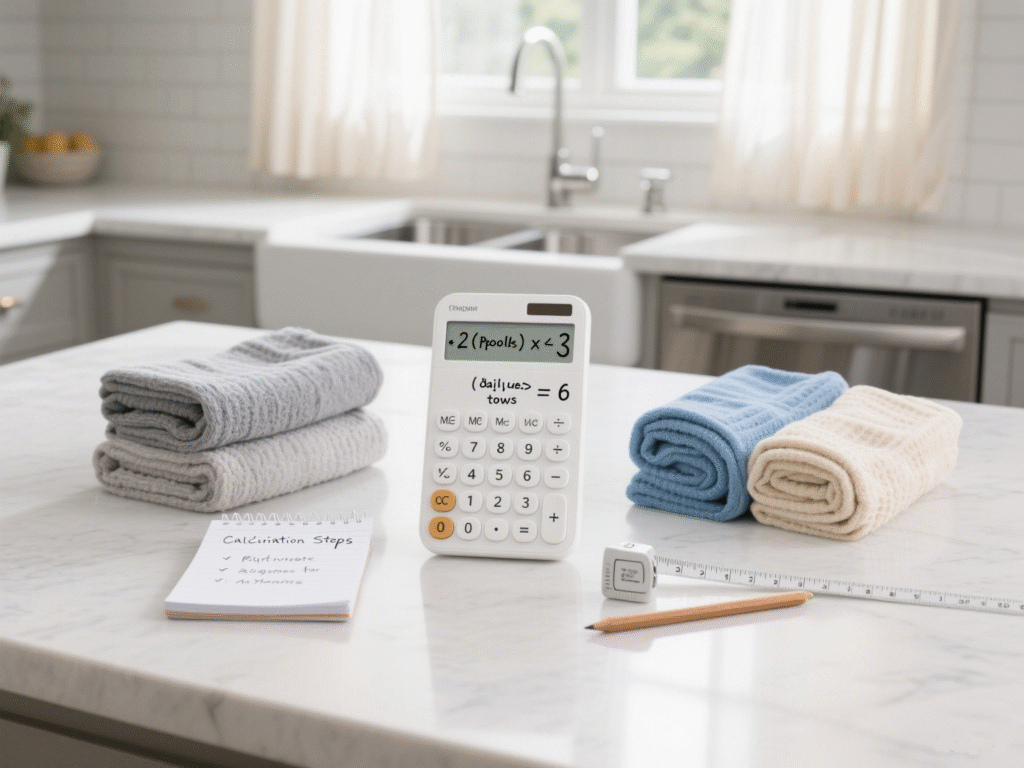
Instead of guessing, you can calculate your “perfect” towel count by considering a few key factors. These aren’t just random numbers—they’re based on how kitchens actually function day-to-day.
Key Factors That Influence Your Towel Needs
- Household size – More people = more hands = more mess. A single cook doesn’t need the same setup as a bustling family of five.
- Meals cooked per day – If you cook most meals at home, expect to double or even triple your towel use compared to someone who mostly eats out.
- Kids & pets – Sticky hands, spilled juice, and water around pet bowls add what we call the “mess multiplier.”
- Wash frequency – If you wash towels every day, you can get away with fewer. If you wash weekly, you’ll need a larger rotation.
- Climate & drying setup – Towels dry slowly in humid climates or homes without a dryer, so extras are essential.
- Kitchen setup – Bigger counters, no dishwasher, or frequent baking means more towels in use at once.
- Diet type – If you handle raw meats often, you’ll want dedicated towels separate from produce and ready-to-eat foods.
Pro Tip: Use Zones for Hygiene and Efficiency
Assigning towels to specific zones prevents cross-contamination and makes your kitchen more organized:
- Hands
- Counters/appliances
- Dishes
- Raw proteins
- Produce
Don’t Forget a Redundancy Factor
Always plan for backups plus a surge buffer. That way, you’re covered during busy cooking weeks, big family meals, or holiday hosting. Nothing is worse than running out of clean towels mid–Thanksgiving dinner prep.
Kitchen Towel Calculator with Real-Life Examples
Now let’s see how this math works in practice.
- Solo light cook in an apartment
- Cooks 2–3 meals/week, does laundry often
- Needs: 6–8 towels total
- Family of four, cooking daily
- Multiple meals at home, dishwasher use, moderate messes
- Needs: 12–18 towels
- Frequent hosts / holiday surge use
- Dinner parties, BBQs, extended family gatherings
- Needs: 20–30 towels (including “event-only” towels)
Kitchen Towel Starter Kits – How Many to Buy at First
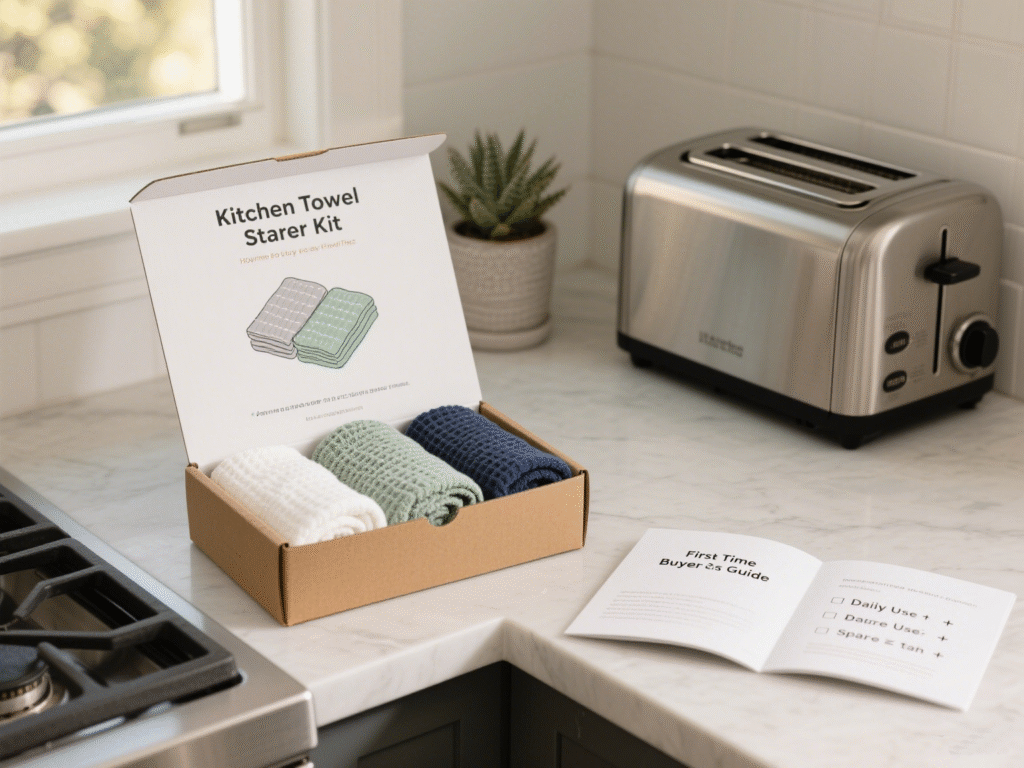
If you’re setting up a kitchen for the first time—or replacing an old mismatched collection—starting with a ready-made “kit” approach helps ensure you’re never short on clean towels. The right kit size depends on your household size, cooking frequency, and budget.
Budget Starter Kit
- Quantity: 12–16 towels
- Best for: Couples, singles, or small households
- Why it works: Provides just enough towels for daily use with a small backup, especially if you do laundry frequently.
Standard Starter Kit
- Quantity: 18–24 towels
- Best for: Most families with kids or households that cook at least one meal per day
- Why it works: Balances affordability with practicality. You’ll have enough to rotate through different kitchen zones (hands, counters, dishes) without constant washing.
Premium Starter Kit
- Quantity: 24–30 towels
- Best for: Large families, entertainers, or those who meal prep heavily
- Why it works: Offers the most flexibility with specialty options (like flour-sack or bar mop towels) and ensures you’ll always have extras for guests, holidays, or messy cooking sessions.
Kitchen Towel Types Explained – So You Know What You’re Counting
Not all “kitchen towels” are created equal. Understanding the differences helps you build a collection that actually works for your cooking and cleaning style.
Common Types of Kitchen Towels
- Kitchen towel – The all-purpose workhorse. Usually cotton, designed for wiping counters, drying hands, and tackling small spills.
- Tea towel – Thin, often made of linen or cotton-linen blends. Traditionally decorative but practical for polishing glassware or covering baked goods.
- Dish towel – Designed specifically for drying dishes and glassware. They’re usually thinner to minimize lint and streaks.
- Bar mop – Thick, absorbent cotton towels, similar to what you’d see in restaurant kitchens. Ideal for soaking up heavy spills or greasy messes.
- Flour sack – Lightweight, lint-free cotton with a smooth finish. Perfect for bread proofing, straining, or covering dough.
- Microfiber towel – Ultra-absorbent and fast-drying. Best for cleaning counters, appliances, or glass surfaces without leaving streaks.
Textile Terms You Should Know
- GSM (grams per square meter): The higher the GSM, the thicker and more absorbent the towel. Lower GSM = lighter, faster drying.
- Loop terry: The classic “fluffy” towel weave. Great for hand-drying and general use.
- Waffle weave: A textured weave that dries quickly and resists mildew, making it excellent for humid environments.
- Cotton vs linen vs microfiber:
- Cotton – Soft, absorbent, durable; the standard choice for multipurpose towels.
- Linen – Strong, smooth, and quick-drying; excellent for glassware and higher-end kitchens.
- Microfiber – Highly absorbent, fast-drying, and streak-free; great for cleaning and polishing.
Why Kitchen Towels Are Important in Every Household
Kitchen towels aren’t just “nice to have”—they’re one of the hardest-working tools in your home. A well-stocked supply saves money, reduces waste, and keeps your kitchen running smoothly.
Quick & Efficient Spill Cleanup
Accidents happen—water splashes, coffee spills, or kids knocking over juice. A kitchen towel absorbs the mess in seconds, without the endless rolls of paper towels.
Essential for Food Preparation
From covering rising dough to drying freshly washed produce, towels often play a silent but critical role in cooking. Many chefs even keep a towel at their side like an extension of their hands.
Hygienic Hand & Dish Drying
Unlike paper towels, which can shred or leave lint, kitchen towels dry hands and dishes more effectively. Choosing the right towel type (like flour sack or linen) ensures streak-free results.
Eco-Friendly Paper Towel Alternative
Reusable towels dramatically cut down on paper towel waste. Over a year, the switch can save families hundreds of dollars and keep countless rolls out of landfills.
👉 Related searches: uses of kitchen towels, kitchen towel vs paper towel
Special Cases – How Many Kitchen Towels Do I Need with Kids, Pets, or Guests?
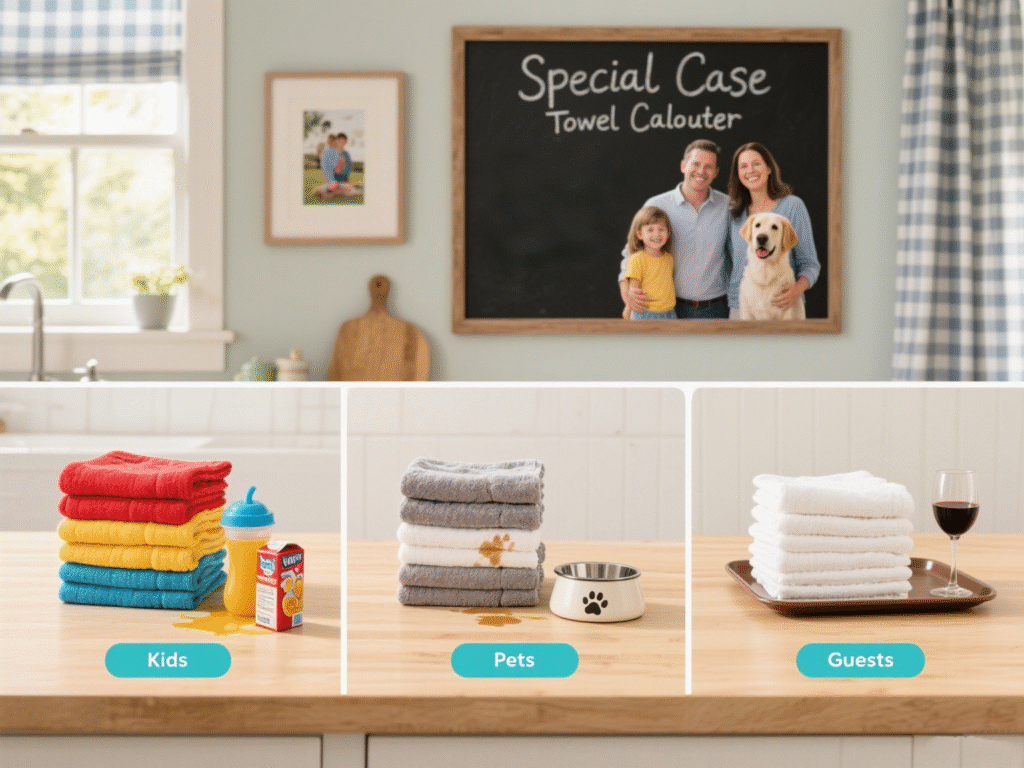
Most households can follow the standard towel count, but certain situations demand extra redundancy. If your kitchen fits into one of these categories, here’s how to adjust.
Homes with Kids or Pets
Sticky hands, spilled juice boxes, art projects, muddy paws, and water around pet bowls all add up to double the mess. Families with young kids or multiple pets should plan on twice the average number of towels—with separate sets for food use versus general cleanup.
No Dishwasher Households
Washing dishes by hand requires extra dish towels. Instead of drying a few glasses, you’ll be tackling full sink loads, which means you’ll cycle through towels much faster. Plan for 5–7 dedicated dish towels in addition to your main rotation.
Kosher, Halal, or Allergy-Sensitive Kitchens
Strict separation of food zones is essential. You may need entirely separate towel sets for meat, dairy, produce, and allergen-free prep areas. Color-coding becomes especially valuable here.
Outdoor Cooking & BBQ Enthusiasts
Grilling, smoking, or frying outdoors adds grease, soot, and heavy-duty messes that regular towels can’t handle. Keep a separate stash of bar mops or dark-colored towels just for these tasks so you don’t ruin your everyday set.
Airbnb & Short-Term Rentals
Hosts should stock towels per stay rather than per week. A good rule of thumb is 4–6 towels per guest stay, ensuring cleanliness and convenience while reducing laundry turnover pressure.
How Often Should You Change Kitchen Towels?
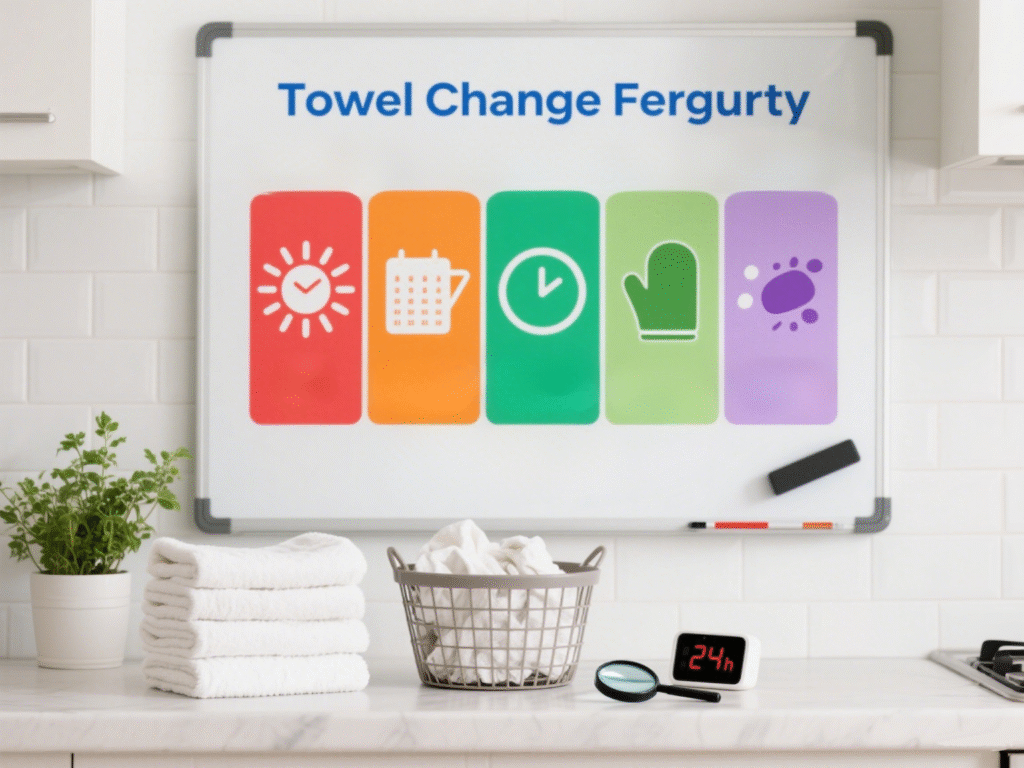
Even if you own the perfect number of kitchen towels, hygiene depends on how often you actually rotate them. Towels can quickly become breeding grounds for bacteria if they stay damp or are used across multiple tasks.
For a cleaner, safer, and more stylish kitchen, customers are encouraged to explore the trusted range of products at [BCHtowel]—where quality meets care.
General Best Practice
Swap towels every 1–2 days under normal use. If a towel has been left damp overnight or starts smelling musty, replace it immediately. Towels used with raw proteins (meat, poultry, seafood) should be swapped out right after contact to avoid cross-contamination.
Risks of Overusing Towels
- Bacteria buildup: Damp towels provide the perfect environment for harmful microbes.
- Cross-contamination: Using the same towel for raw chicken and clean dishes is a recipe for foodborne illness.
- Mold & mildew: Towels that never fully dry can develop unpleasant odors and stains.
Towel Longevity & Replacement Cycle
Most kitchen towels last 1–3 years, depending on quality and care. Signs it’s time to replace include:
- Permanent stains or lingering odors
- Fraying edges or thinning fabric
- Loss of absorbency (towels just push water around)
👉 Related searches: how often to change kitchen towels, are kitchen towels hygienic, how long do dish towels last
Kitchen Towel Color-Coding and Zoning System
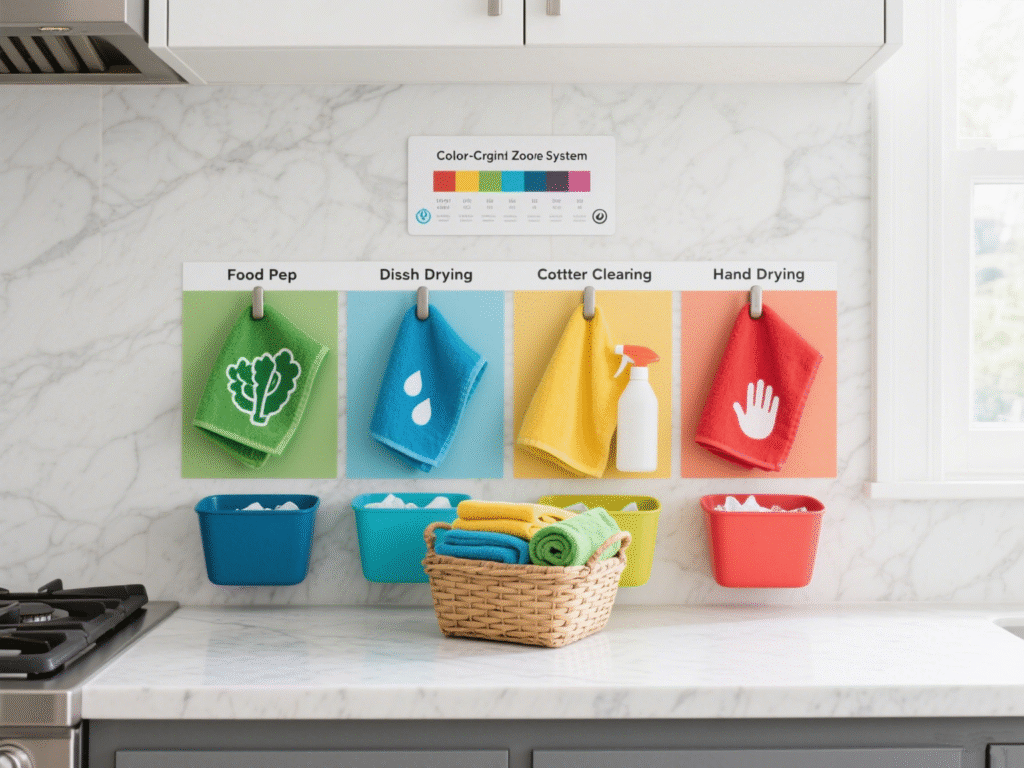
Using a color-coded towel system is one of the easiest ways to maintain hygiene, prevent cross-contamination, and keep your kitchen organized. Assigning specific towels to each zone ensures that towels are used correctly every time.
Recommended Color Assignments per Zone
| Zone | Towel Color Example | Notes |
|---|---|---|
| Hands | White | Easy to bleach clean, keeps visible stains in check |
| Counters | Blue | Everyday wipe-downs, easily distinguishable |
| Dishes | Green | Lint-free and absorbent for glass and dishware |
| Raw Proteins | Red | Prevents cross-use contamination with cooked or ready-to-eat foods |
| Produce | Yellow | Gentle on delicate foods, visually separates from proteins |
Storage & Rotation Tips
- Keep towels in labeled drawers, baskets, or hooks near each zone for easy access.
- Rotate clean and dry towels daily to prevent bacteria buildup.
- Consider having extra backups per zone, especially for high-use areas like hands and counters.
Benefits of Color-Coding
- Reduces risk of cross-contamination between raw and ready-to-eat foods.
- Helps family members or roommates follow hygiene rules without guessing.
- Makes towel management easier during busy cooking or entertaining days.
Cost and Sustainability – How Many Kitchen Towels Save Money vs Paper Towels
Switching from disposable paper towels to reusable kitchen towels isn’t just convenient—it’s also a smart financial and environmental choice.
Cost-Per-Use Advantage
A single high-quality kitchen towel can last hundreds of uses, whereas a roll of paper towels is used once and discarded. Over time, this drastically lowers your per-use cost. Investing in durable towels upfront pays off quickly.
Yearly Savings
Families who replace paper towels with kitchen towels can save approximately $200–$400 per year, depending on household size and cooking habits. This includes both regular meal prep and cleanup after spills or snacks.
Environmental Footprint
While washing towels consumes water and energy, the long-term environmental impact is far lower than constant paper towel disposal. Reusable towels reduce landfill waste, conserve trees, and decrease packaging waste, making them an eco-friendly choice for every kitchen.
Kitchen Towel Hygiene Myths Debunked
Kitchen towels are essential, but misinformation about their care can lead to unsafe or inefficient practices. Let’s separate fact from fiction.
Myth 1: “Air-Drying Overnight Makes It Safe”
❌ Reality: Towels left damp overnight can harbor bacteria and mold, even if they appear dry. Always rotate towels daily and wash them regularly to maintain hygiene.
Myth 2: “One Towel for Everything Is Fine”
❌ Reality: Using a single towel for hands, dishes, counters, and raw foods spreads bacteria and increases the risk of cross-contamination. Assign towels to specific zones or tasks.
Myth 3: “Microfiber Always Beats Cotton”
❌ Reality: Microfiber is excellent for counters and appliances, but cotton or linen performs better with high-heat tasks, like drying dishes or handling hot cookware. Choose the right material for the job.
Myth 4: “Hot Water Ruins Towels”
❌ Reality: Washing towels in hot water actually keeps them hygienic, removes grease, and extends their lifespan. Avoid fabric softeners, which reduce absorbency, but don’t fear high temperatures.
Kitchen Towel Materials & Weaves – Choosing the Right Type and Count
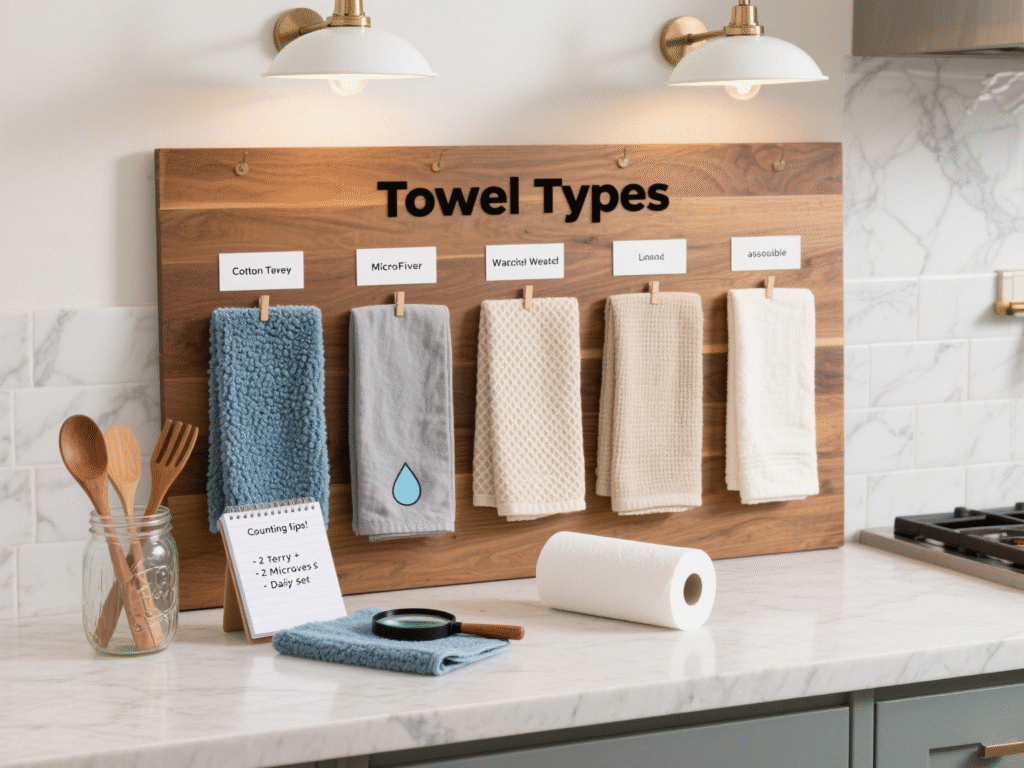
Not all towels are created equal. The material and weave affect absorbency, durability, drying time, and suitability for specific tasks. Knowing the differences ensures you stock the right towels for each purpose.
Cotton Terry
- Characteristics: Thick, soft, highly absorbent, and durable
- Best for: Hands, general-purpose wiping, and heavy-duty spills
- Tip: Look for high GSM (grams per square meter) for maximum absorbency
Waffle Weave
- Characteristics: Lightweight, textured weave, quick-drying
- Best for: Hand drying, counters, or everyday light tasks
- Tip: Ideal for humid environments or small kitchens without a dryer
Flour-Sack Towels
- Characteristics: Thin, smooth, lint-free cotton
- Best for: Drying dishes, proofing dough, straining foods
- Tip: Use for tasks that require precision and streak-free results
Linen
- Characteristics: Strong, fast-drying, slightly luxurious feel
- Best for: Glassware, fine dishware, or upscale kitchens
- Tip: More expensive, but lasts longer if cared for properly
Microfiber
- Characteristics: Ultra-absorbent, streak-free, quick-drying
- Best for: Counters, appliances, stainless steel, and spills
- Tip: Not ideal for hot tasks; pair with cotton or linen for versatile use
Matching Towels to Tasks
| Task | Recommended Material/Weave | Notes |
|---|---|---|
| Hands | Cotton terry or waffle | Soft, absorbent, comfortable |
| Counters | Microfiber or bar mop | Quick-drying, streak-free |
| Dishes | Flour-sack or linen | Lint-free, polished finish |
| Raw Proteins | Color-coded cotton/microfiber | Use separate towel; discard or wash immediately |
FAQs
Most homes need 8–12 kitchen towels, while large families or frequent cooks may need 15–20. Plan for 2–3 towels per person per week.
Change towels every 1–2 days, or immediately if they get damp, greasy, or used for raw food.
Chefs keep one dry towel for hot pans and hands, and one damp towel for wiping surfaces or securing cutting boards.
Use separate towels for dishes, hands, and cleaning. Never mix raw food cleanup with general use, and wash towels often in hot water.
Replace when towels lose absorbency, smell even after washing, fray, or develop stains that don’t wash out.
On average, buy new towels every 12–18 months. Heavy-use kitchens may need replacements every 6–12 months.


